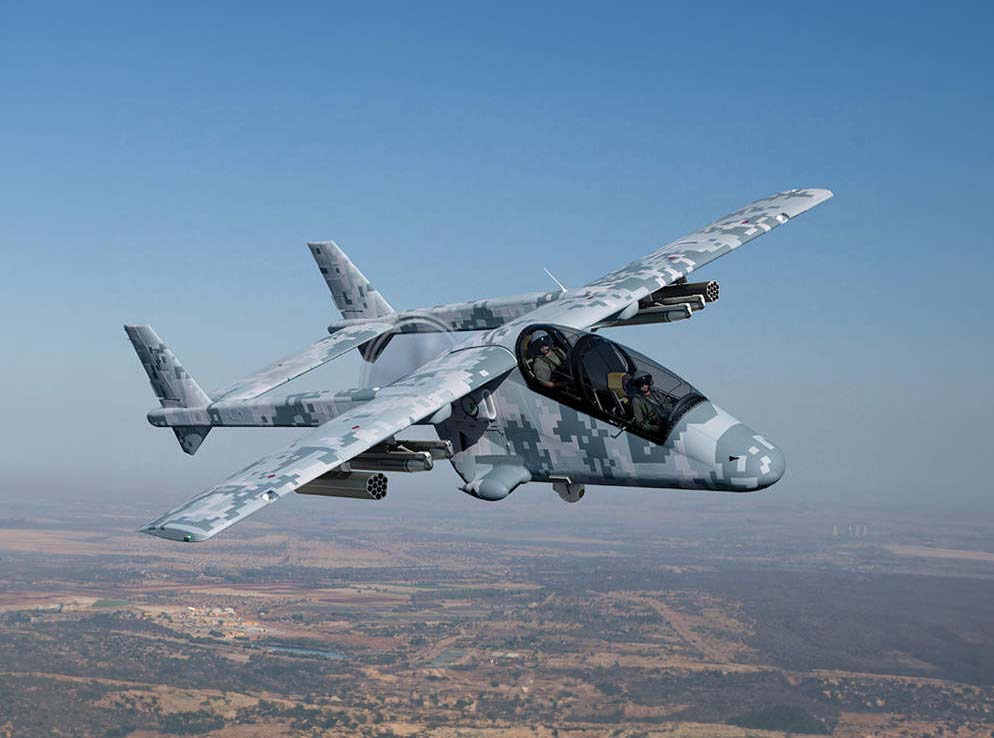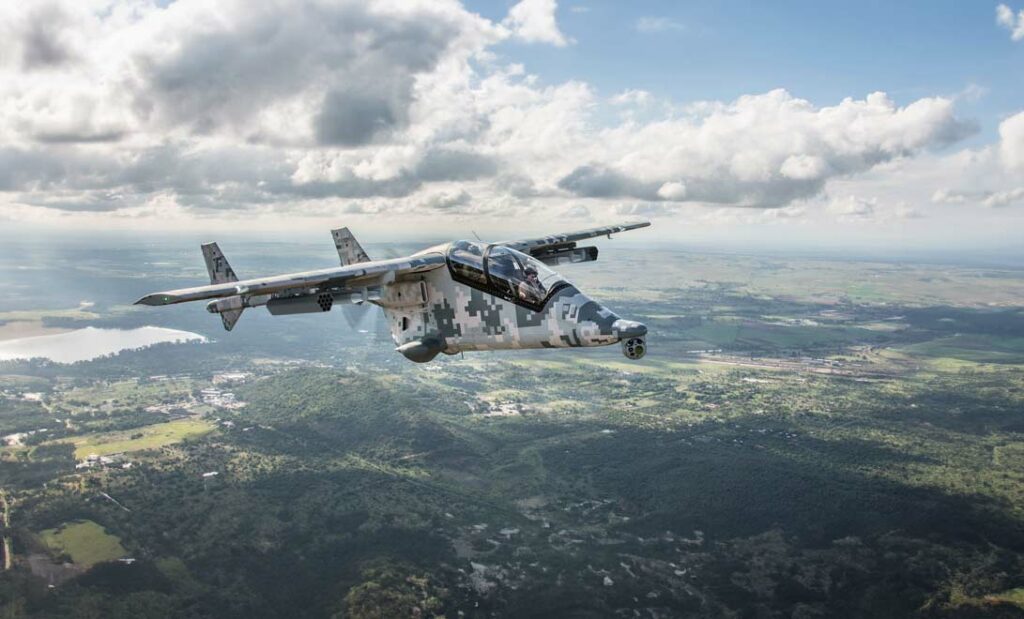The Paramount AHRLAC (Mwari) is a South African twin-boom, pusher-prop reconnaissance and light strike aircraft, featuring a Pratt & Whitney PT6A-66B engine, modular mission systems, and STOL capabilities.
The Paramount AHRLAC (Advanced High Performance Reconnaissance Light Aircraft), also known as Mwari, is a South African-designed twin-boom, high-wing aircraft powered by a single Pratt & Whitney PT6A-66B turboprop engine producing 950 horsepower (710 kW). It features a pusher configuration, modular mission systems, and is capable of short takeoff and landing (STOL) operations. The aircraft has a maximum takeoff weight of 3,800 kilograms (8,378 pounds), a service ceiling of 31,000 feet (9,450 meters), and a maximum cruise speed of 272 knots (500 kilometers per hour). Its design emphasizes versatility, allowing for rapid reconfiguration to perform various roles, including intelligence, surveillance, reconnaissance (ISR), light attack, border patrol, and maritime surveillance missions. The Mwari’s modular payload system supports a range of sensors and weaponry, making it adaptable to diverse operational requirements.
History of Development
In the late 2000s, recognizing a gap in the market for a cost-effective, multi-role aircraft capable of performing both reconnaissance and light attack missions, Paramount Group initiated the development of the AHRLAC. The objective was to create an affordable platform that could operate in various roles, including border control, anti-smuggling, disaster relief, and counter-insurgency operations. The program was officially launched in 2011 as a joint venture between Paramount Group and Aerosud, a South African aerospace company.
The design phase focused on creating an aircraft that was not only versatile but also easy to maintain and operate in austere environments. The development team emphasized a modular design, allowing for quick reconfiguration to suit different mission requirements. This approach aimed to provide operators with a flexible and cost-effective solution compared to traditional unmanned aerial vehicles (UAVs) and more expensive light attack aircraft.
On 26 July 2014, the AHRLAC prototype conducted its maiden flight from Wonderboom Airport near Pretoria, South Africa. This milestone marked the first flight of a fully indigenous military aircraft developed in Africa since the Denel Rooivalk attack helicopter. Following the successful first flight, the aircraft was publicly displayed on 13 August 2014 at Wonderboom Airport, showcasing its capabilities to potential customers and stakeholders.
In March 2016, Paramount Group announced a partnership with Boeing to develop a militarized version of the AHRLAC, named Mwari. This collaboration aimed to integrate advanced intelligence, surveillance, and reconnaissance (ISR) systems, as well as light strike capabilities, enhancing the aircraft’s operational effectiveness. The Mwari variant was designed to meet the specific needs of special operations forces, with features such as rapid deployment and modular mission systems.
The development of the AHRLAC/Mwari occurred during a period when many nations were seeking cost-effective solutions to address asymmetric warfare, border security, and surveillance challenges. Traditional high-performance military aircraft were often too expensive and complex for these roles, leading to a demand for versatile platforms like the AHRLAC/Mwari that could perform multiple missions at a lower cost.
Throughout its development, the AHRLAC/Mwari program faced various challenges, including financial constraints and the need to establish a production facility capable of meeting anticipated demand. Despite these obstacles, Paramount Group successfully advanced the program, leading to the commencement of full-scale production in 2018. The aircraft’s design and capabilities have attracted interest from various countries, particularly those seeking affordable and adaptable solutions for their defense and security needs.

Design
The Paramount AHRLAC (Mwari) features a distinctive twin-boom configuration with a high-mounted, slightly forward-swept wing spanning 12 meters (39.4 feet). The aircraft’s length is 10.5 meters (34.4 feet), and it stands at a height of 4 meters (13.1 feet). This design provides excellent visibility for the crew and contributes to the aircraft’s stability and handling characteristics.
Constructed using a combination of metal and composite materials, the airframe balances durability and weight efficiency. The high-wing design not only enhances visibility but also allows for operations from unprepared airfields, a crucial feature for missions in remote or austere environments. The aircraft’s retractable tricycle landing gear is optimized for short takeoff and landing (STOL) capabilities, requiring a takeoff distance of approximately 550 meters (1,804 feet) with a full payload.
The Mwari is powered by a single Pratt & Whitney PT6A-66B turboprop engine, delivering 950 horsepower (710 kW) in a pusher configuration. This engine choice provides a balance between performance and fuel efficiency, enabling the aircraft to achieve a maximum cruise speed of 272 knots (500 kilometers per hour or 311 miles per hour) and a service ceiling of 31,000 feet (9,450 meters). The pusher configuration also reduces the risk of foreign object damage during takeoff and landing from unprepared surfaces.
A key feature of the Mwari’s design is its modular mission system. The aircraft incorporates an Interchangeable Multi-Mission Pod System (IMPS) located beneath the cockpit, allowing for rapid reconfiguration to suit various mission profiles. This system supports the integration of different sensor packages, including electro-optical/infrared (EO/IR) cameras, synthetic aperture radar (SAR), electronic intelligence (ELINT), and communication intelligence (COMINT) systems. The open-architecture design ensures compatibility with a range of payloads, making the aircraft adaptable for different operational needs.
Performance
The Paramount AHRLAC (Mwari) is powered by a Pratt & Whitney PT6A-66B turboprop engine, delivering 950 horsepower (710 kW). This powerplant allows the aircraft to operate efficiently at different altitudes and speeds while maintaining low operational costs. The pusher configuration improves aerodynamics, reducing drag and enhancing fuel efficiency.
The aircraft has a maximum cruise speed of 272 knots (500 km/h or 311 mph), which allows for rapid deployment and reconnaissance operations. Its service ceiling reaches 31,000 feet (9,450 meters), providing a high vantage point for surveillance and engagement.
The range of the Mwari is 2,000 nautical miles (3,704 km or 2,300 miles) with external fuel tanks, enabling long-endurance missions without refueling. This endurance makes the aircraft suitable for border patrol, counter-insurgency, and maritime surveillance roles.
With a maximum takeoff weight of 3,800 kilograms (8,378 pounds) and an empty weight of approximately 2,000 kilograms (4,409 pounds), the aircraft can carry a significant payload. It has a maximum payload capacity of 800 kilograms (1,764 pounds), allowing for a mix of weapons, sensors, and additional fuel.
The short takeoff and landing (STOL) capability allows operation from unprepared runways as short as 550 meters (1,804 feet). This makes the Mwari highly effective for operations in remote and rugged environments where traditional aircraft might struggle.
Variants
- AHRLAC Base Model – The original reconnaissance and light strike configuration, featuring modular mission systems for ISR roles.
- Mwari (Military Version) – An armed variant equipped with weapon pylons, enhanced sensor integration, and a modular payload system.
- Civil Variant – A non-military version intended for border patrol, disaster relief, and surveillance missions.

Military Use and Combat
The Mwari variant was developed specifically for light strike and ISR roles. It features six hardpoints, capable of carrying air-to-ground munitions, guided rockets, and air-to-air missiles. The underwing pylons support a variety of weapon systems, including:
- 70mm guided rockets
- 250 lb precision-guided bombs
- Air-to-ground missiles
- 7.62mm and 12.7mm gun pods
- Electronic warfare pods
The aircraft is designed for counter-insurgency (COIN), border surveillance, and anti-smuggling operations. The EO/IR sensor systems enable day and night operations, and the synthetic aperture radar (SAR) enhances targeting capabilities in adverse weather conditions.
The Mwari has been marketed to multiple countries for defense and security applications, particularly in Africa, Asia, and South America. Some nations have shown interest in the aircraft as an alternative to helicopter-based COIN operations due to its lower operational cost and longer endurance.
The aircraft’s ability to operate from austere airstrips makes it valuable for forces engaged in asymmetric warfare, where rapid deployment and persistent surveillance are crucial. It has been considered as a cost-effective alternative to platforms such as the A-29 Super Tucano and AT-6 Wolverine, offering similar strike capabilities but with a greater emphasis on modular mission adaptability.
The Paramount AHRLAC (Mwari) fills a unique niche in the market, offering a multi-role light strike and reconnaissance aircraft with modular adaptability, STOL capability, and cost-effective operation. Powered by a reliable Pratt & Whitney PT6A-66B engine, it provides a balance of endurance, speed, and firepower suited for counter-insurgency, border surveillance, and ISR missions. Its modular mission pod system and interchangeable payloads allow it to perform a variety of roles without significant reconfiguration time.
Compared to other light attack aircraft like the A-29 Super Tucano, the Mwari offers a unique combination of ISR capabilities and weapons flexibility, making it a competitive option for nations needing an affordable, multi-mission aircraft. While its armament and speed do not match jet-powered strike aircraft, its low operational cost, long endurance, and STOL performance provide strategic advantages in reconnaissance and counter-insurgency missions.
The aircraft is positioned as a versatile and economical solution for both military and security forces, capable of adapting to diverse mission profiles in complex operational environments.
Back to the Special Aircraft section